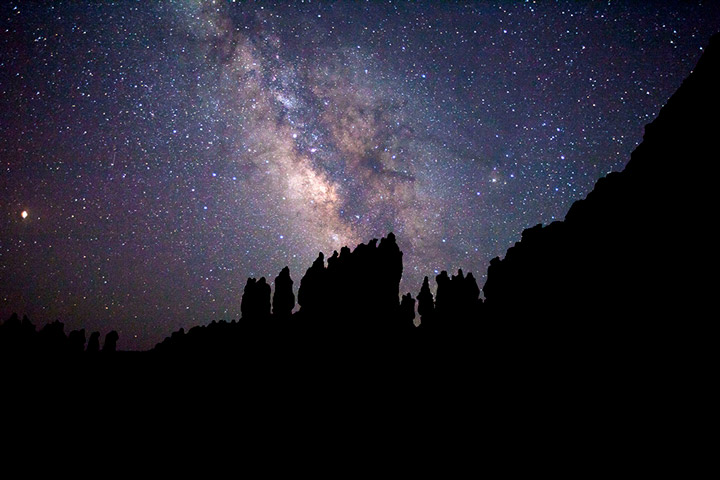

Bryce Canyon National Park in the daytime is known for its spire-shaped rock formations, bowl-shaped natural amphitheaters, and diverse wildlife, including pronghorn antelope, peregrine falcons, and rattlesnakes. But the park, made up of 56 square miles (145 square kilometers) of protected land in southern Utah, is just as spectacular at night.
The lack of urban light around Bryce Canyon stands out in the nighttime image above, especially compared to Las Vegas, located about 200 miles (320 kilometers) southwest of the park. The image was captured by the VIIRS (Visible Infrared Imaging Radiometer Suite) on the Suomi NPP satellite. The image comes from the instrument’s “day-night band,” which detects light in a range of wavelengths from green to near-infrared and uses filtering techniques to observe signals such as auroras, city lights, and reflected moonlight.
Bryce Canyon received international dark sky status in 2019, joining more than 200 sites worldwide that are taking steps to protect people and wildlife from urban light pollution. In Bryce Canyon, for example, there’s an effort to replace out-of-compliance light fixtures with shielded lights, which direct the light down instead of up.


In the park at night, people can see thousands of stars, planets such as Venus and Jupiter, nocturnal wildlife, and the Milky Way, said Kevin Poe, a park ranger and program analyst at Bryce Canyon National Park.
“The first thing people would notice is how the Milky Way extends from horizon to horizon,” Poe said. “You might refer to it as a great big silver rainbow.” Planets like Venus and Jupiter can be bright enough to cast a person’s shadow on the ground, he added.
With less artificial light, human eyes and camera sensors can better distinguish celestial light. In these photos, for example, notice the abundance of stars and the band of the Milky Way stretching across the night sky.
The rock wall with its slots and cracks, visible in the second photo, is called a “fin.” These fins divide Bryce Canyon’s main amphitheater into intricate watersheds and create the maze-like terrain the park is well-known for. Rainwater runoff and frost wedging—where water slips into rock cracks, freezes, and breaks up the rock—contribute to the weathering that shapes these rock patterns.
The park is not technically a canyon; its amphitheaters were sculpted by rains and the draining of melting snow, unlike most canyons that are shaped by flowing rivers. The image above, acquired on May 7, 2024, by the OLI-2 (Operational Land Imager-2) on Landsat 9, shows a daytime view of the park.
Poe suggests visitors take time to appreciate the park’s unique geologic terrain—and then continue their stay into the night.
“There’s a whole other experience to be had after the sun goes down,” Poe said. “So, stick around.”
NASA Earth Observatory images by Michala Garrison, using VIIRS day-night band data from the Suomi National Polar-orbiting Partnership and Landsat data from the U.S. Geological Survey. Photos by Keith Moore/NPS. Story by Tayler Gilmore.